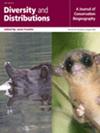Improving the Accuracy of Predicted Potential Distributions and Enhancing the Effectiveness of Priority Conservation Areas for Protected Species by Expanding the Target Area
Abstract
Aim
Subjective study area delineation in conservation planning often overlooks species occurrences integrality, truncating the ecological niches. Incorporating occurrences from expanded areas into species distribution prediction within the study area provides an innovative approach to mitigate negative impacts, but the conservation effectiveness of this approach requires further clarification.
Location
We selected the Southeast Himalaya Biodiversity Priority Conservation Area and the Himalayas biogeographic region as the target and expanded areas, respectively.
Methods
We set three scenarios by extracting species occurrences from the target area, expanded area, and both areas (scenarios 1, 2, and 3, respectively). Using MaxEnt for predicting the potential distributions of species (SPDs) and Zonation for identifying priority conservation areas (PCAs) across the three scenarios, we evaluated the SPD prediction accuracy, conservation effectiveness, and ecological representativeness.
Results
Incorporating data from the expanded area in scenarios 2 and 3 improved the prediction accuracy and covered a wider SPD range than scenario 1. High-richness areas and PCAs in scenarios 2 and 3 were identified in the Kangrigebu South Wing Mountains, Salween and Lancangjiang Incisive Mountains, and southern Brahmaputra Great Turn and Upper Salween Incisive Mountains. These PCAs improved the coverage of the SPD areas (77.74%–82.20%) and priority forest and wetland ecosystems (11.86%–12.84%). In contrast, the PCAs in scenario 1 had a relatively larger distribution in the Himalayas Central Mountains, covering a higher proportion of their own SPD areas (83.75%) and priority steppe ecosystem (31.55%). Overall, scenarios 2 and 3 demonstrated greater conservation effectiveness and ecological representativeness, with minimal differences between them, and both outperformed scenario 1.
Main Conclusions
Our study proposed an innovative approach that expanded the study area to biogeographic regions and supplemented species occurrences from these expanded areas, thereby improving the prediction accuracy of SPDs and conservation effectiveness, while providing an easily implementable and generalizable framework in data deficient areas.


 求助内容:
求助内容: 应助结果提醒方式:
应助结果提醒方式:


